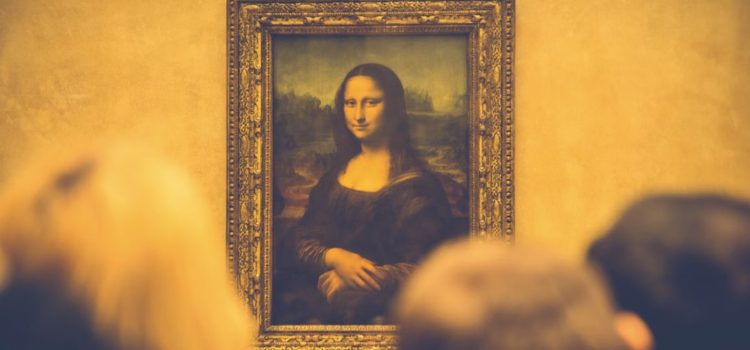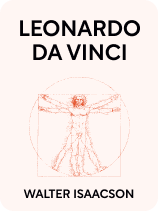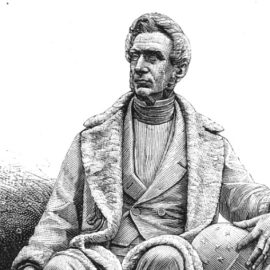

This article is an excerpt from the Shortform book guide to "Leonardo da Vinci" by Walter Isaacson. Shortform has the world's best summaries and analyses of books you should be reading.
Like this article? Sign up for a free trial here.
What is the history of the Mona Lisa painting by Leonardo da Vinci? How did Leonardo paint the artwork?
“Mona Lisa” by Leonardo da Vinci is one of the most famous paintings in the world. The biography Leonardo da Vinci by Walter Isaacson highlights the creative process behind the iconic painting, including how science played into it.
Continue reading to learn the history of the Mona Lisa painting.
The Mona Lisa Painting by Leonardo da Vinci
The Mona Lisa painting by Leonardo da Vinci is arguably his best-known work. Isaacson reports that Leonardo began working on this masterpiece in 1503 and continued perfecting it until his death, putting into practice his knowledge of optics, the human body and psyche, textures, and nature. (Shortform note: You can see the painting in high resolution here.) Francesco del Giocondo, an up-and-coming silk merchant, commissioned Leonardo to paint his wife, Lisa del Giocondo. Possibly, Leonardo agreed to paint her because she wasn’t a noblewoman, and he wouldn’t have to worry about traditional rules for portraits. (Shortform note: Francesco and Lisa never got their commission since Leonardo never turned in the painting. When he died, the portrait stayed in the possession of King Francis I.)
Leonardo applied everything he had learned over the years in this work of art, including these three key sets of insights that Isaacson identifies:
How Optics Work
He applied his knowledge of optics in three creative ways:
1) He departed from traditional methods to take advantage of light and shade. Isaacson explains that Leonardo primed the painting with lead white, instead of the traditional mix artists used at the time. This reflected the light better, even from below the innumerable layers of oil, which added to the luminosity and depth of the painting. He also created shade in his subject’s face with a mixture of iron and manganese, another departure from tradition. This softly delineated her features and mimicked the texture of skin. (Shortform note: Leonardo’s unique mix of pigments allowed him to create the sfumato that characterizes his paintings. Scientists only recently discovered what those pigments were thanks to X-ray studies.)
2) He created an artificial source of light to highlight her features. The light in the painting should be coming from behind her, where the landscape is. However, Isaacson says Leonardo created an artificial light coming from the top left to illuminate her face but he did it inconspicuously so that it wouldn’t feel unnatural. (Shortform note: Unfortunately, the light in the real world has been less kind to the “Mona Lisa.” The cracks in her surface and the darkening of her pigments partly result from the lighting the painting has been under.)
3) He emulated how our eyes work to make the painting more lifelike. To mimic how the eye sees far away objects less clearly, Leonardo made the background diffuse while her hand and body were more clearly delineated. Then, Isaacson explains that Leonardo fixed her eyes on the viewer by playing with how our eyes process light and shades. If you look at a three-dimensional object from different angles, you see it differently, but this doesn’t happen in a two-dimensional plane. Thus, every time you look at her eyes, you see them fixed in the same position, apparently looking straight at you.
(Shortform note: A study suggests that Lisa is not, in fact, looking at you. According to measurements taken while volunteers looked at the painting, Lisa is looking over your right shoulder, not straight at you.)
How Emotions Work
The central element of the Mona Lisa painting by Leonardo, the subject’s smile, is a product of Leonardo’s knowledge of optics, anatomy, and human emotion.
Isaacson reports that Leonardo had been dissecting and drawing human mouths, tracing each layer of muscle and thread of nerve. He then figured out which muscles and nerves created a smile, a purse of the lips, or any other movement of the mouth. In his notebooks, alongside different drawings of dissected mouths, there is a drawing of a smile that looks a lot like Lisa’s.
Besides in-depth knowledge of anatomy, Leonardo used optics to create Mona Lisa’s cryptic smile. Isaacson explains that Leonardo knew that the retina catches the light differently at different points of its surface, which makes the eye see things more or less clearly depending on the angle it uses. When you stare at something directly, you see it in more detail; when you look at it from the corner of your eye, you see the surrounding shadows.
Knowing this, Leonardo delineated her mouth clearly and used shadows to hint at a smile. Isaacson explains that, when you look at her mouth, you see the details but no smile; when you look anywhere else in the painting, you notice the shadows around her mouth and it seems like she’s smiling. Look back at her mouth and you lose her smile.
Using his knowledge of anatomy and optics, Isaacson argues that Leonardo created a smile that was representative of human emotion. It exists beneath the surface, not clearly delineated but shaped by the surrounding shadows. (Shortform note: Mona Lisa’s smile elevated the portrait from a regular painting to the most famous painting in the world. For the first time, people looked at a portrait and saw a real person with life in her expression.)
How the Individual Is Part of the Cosmos
Embracing the aesthetic and spiritual aspect of the microcosm-macrocosm analogy, Leonardo made the landscape and Lisa become one. Isaacson explains that the paths and river behind her seem to flow into her with her hair and clothing following the same patterns. Besides the synchronic fusing of Lisa with the earth, the earth is a diachronic blend. Isaacson describes the river shaping the rocks, mountains, and valleys, while the bridge near her shoulder represents human history—all of it culminating in the young woman. (Shortform note: This was not the first time Leonardo used a sitter’s background to convey a history of creation. He accomplished the same effect, for example, in “Virgin of the Rocks.”)

———End of Preview———
Like what you just read? Read the rest of the world's best book summary and analysis of Walter Isaacson's "Leonardo da Vinci" at Shortform.
Here's what you'll find in our full Leonardo da Vinci summary:
- A detailed look into the life, accomplishments, and struggles of Leonardo da Vinci
- Lessons from his life and work that you can apply to your own life
- What set Leonardo apart from other artists at the time






